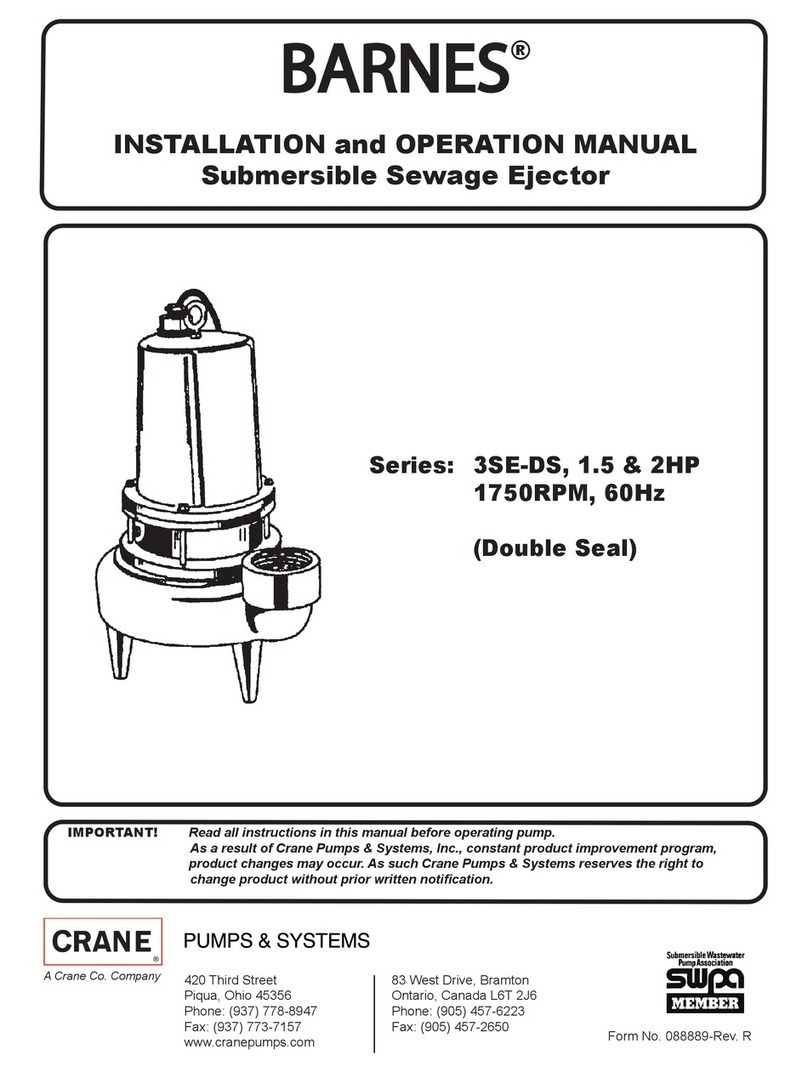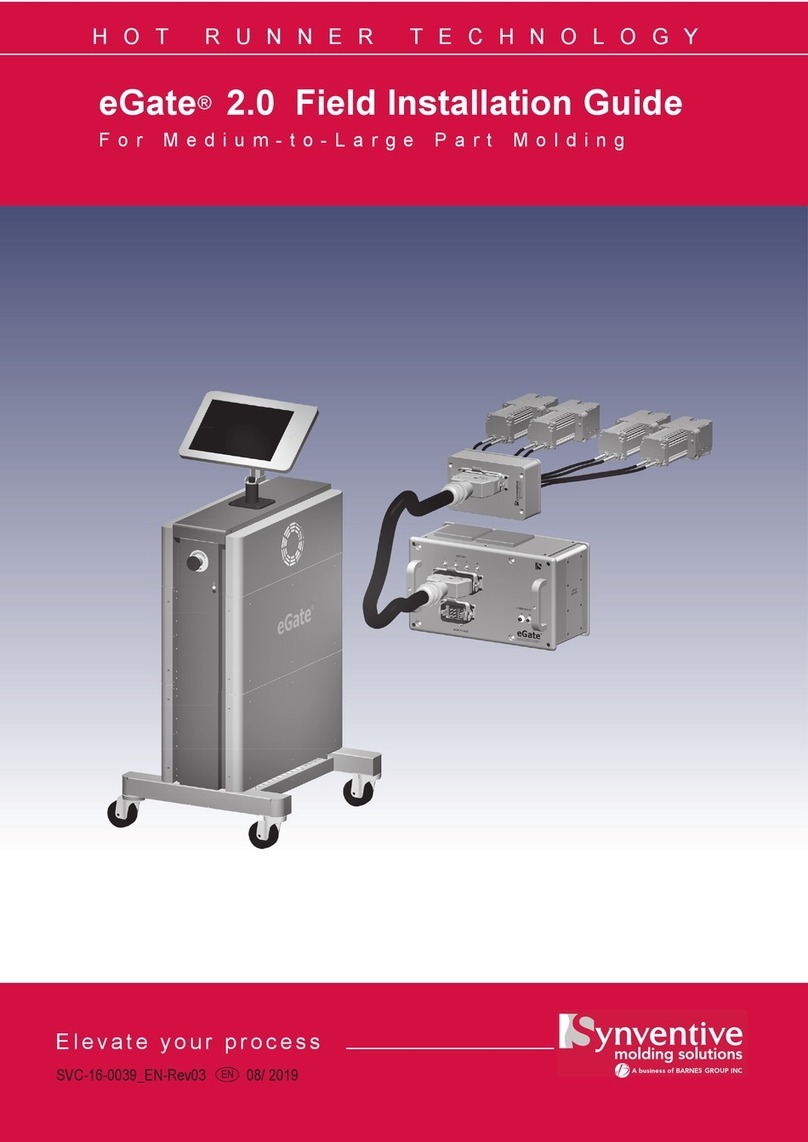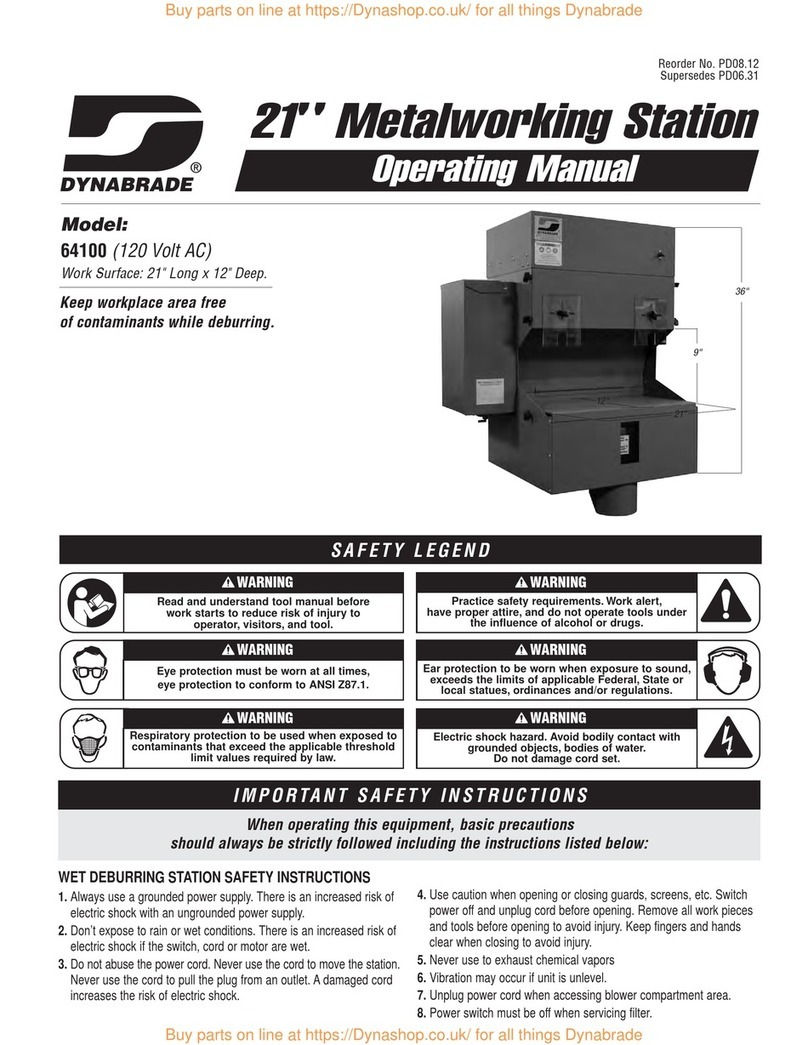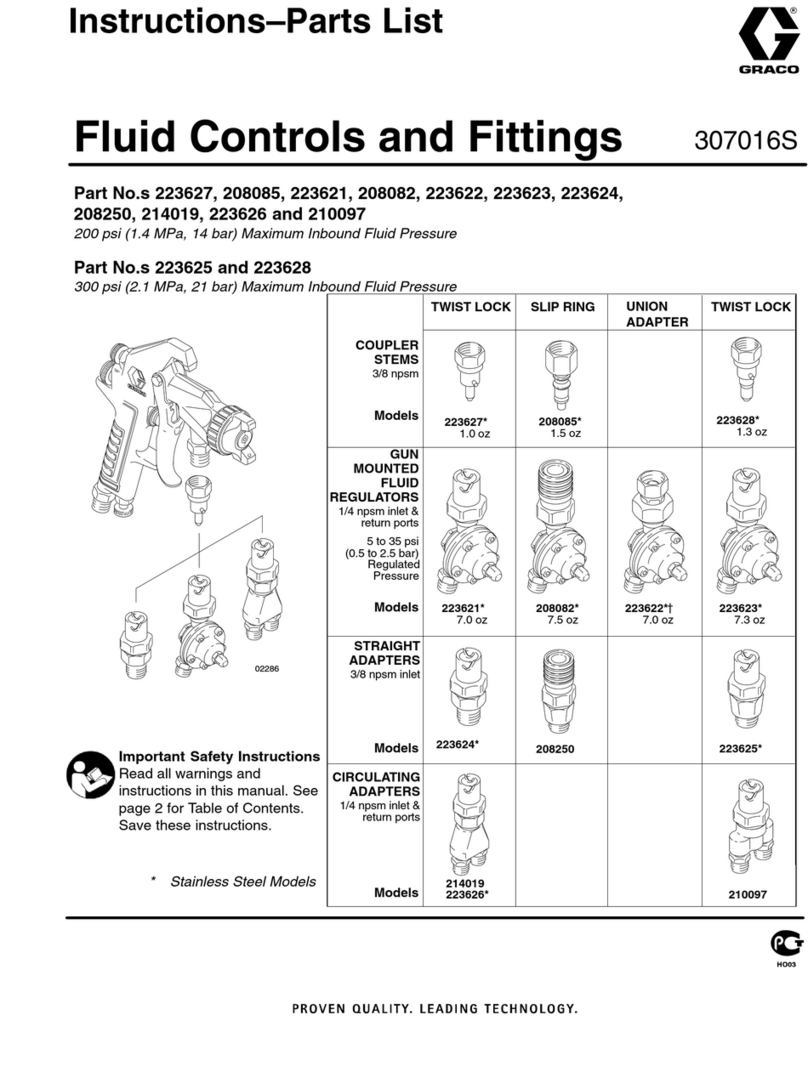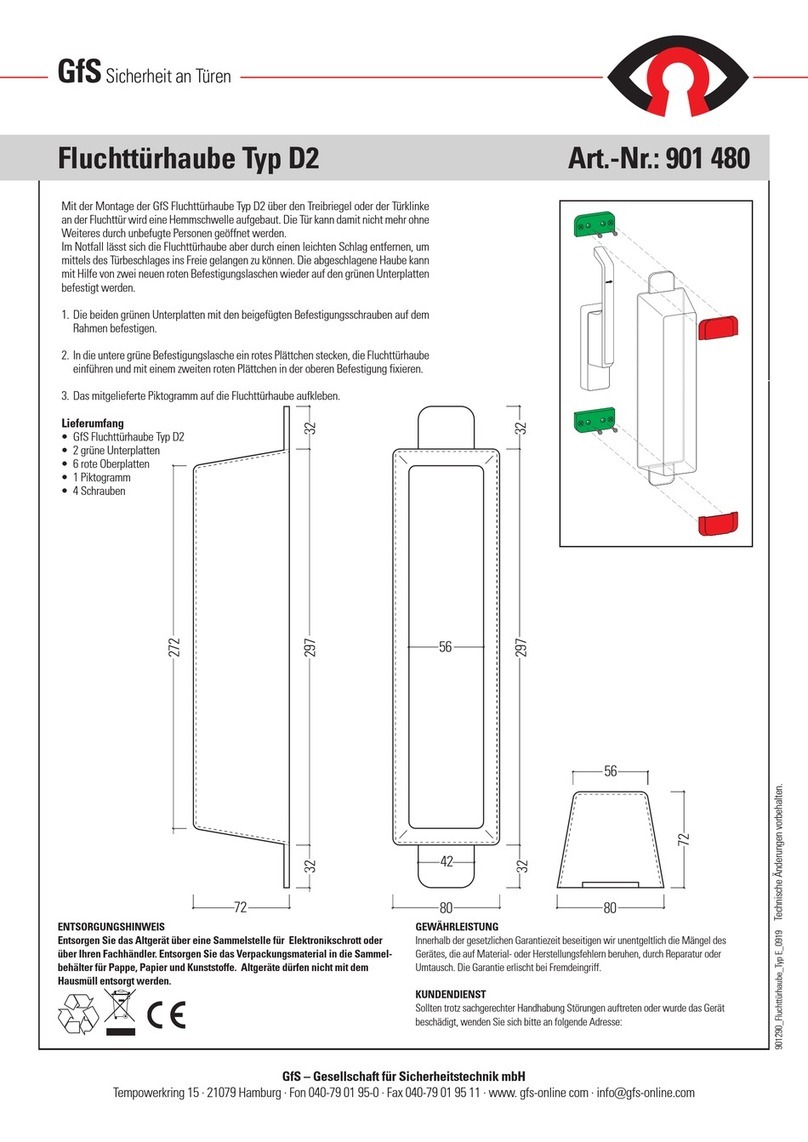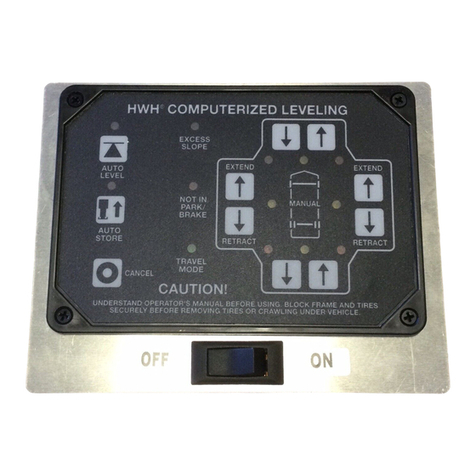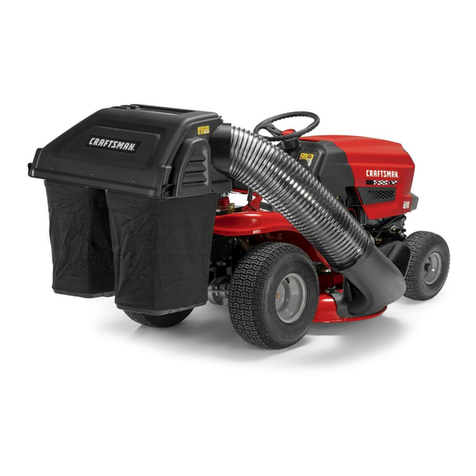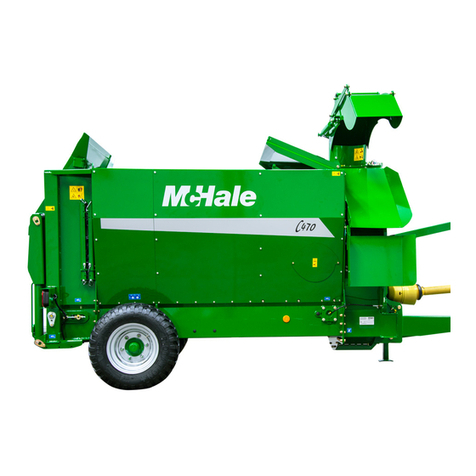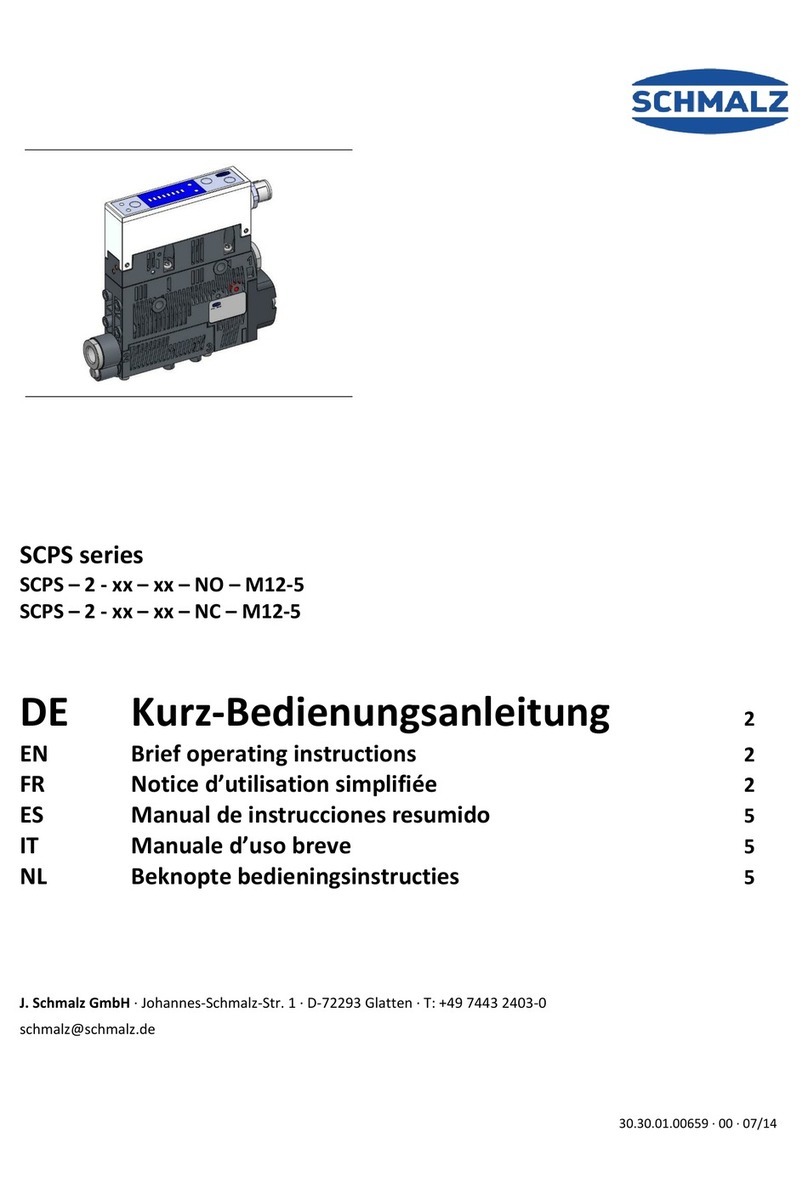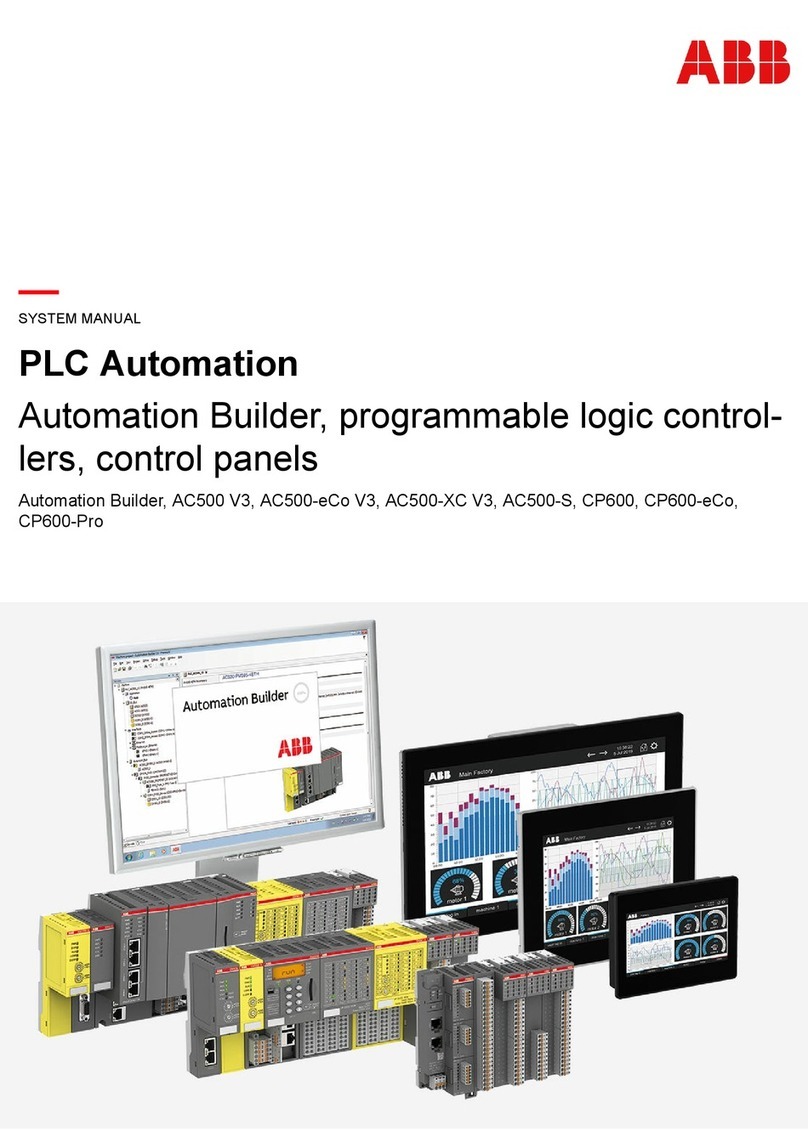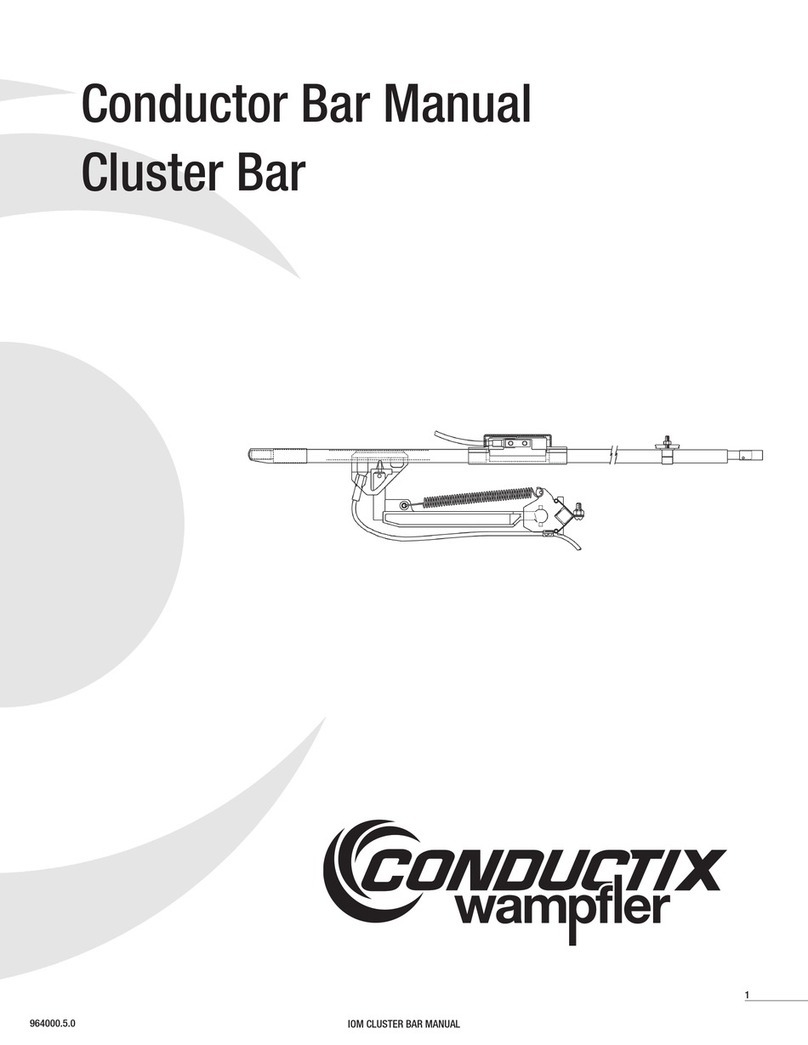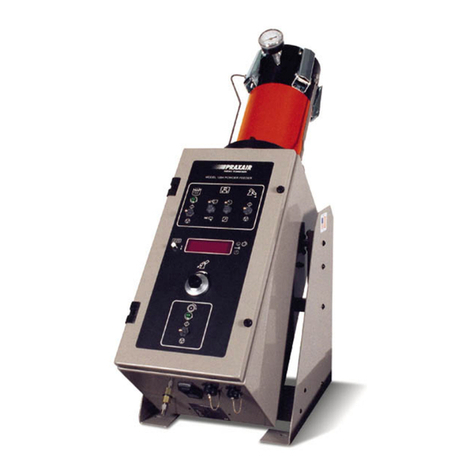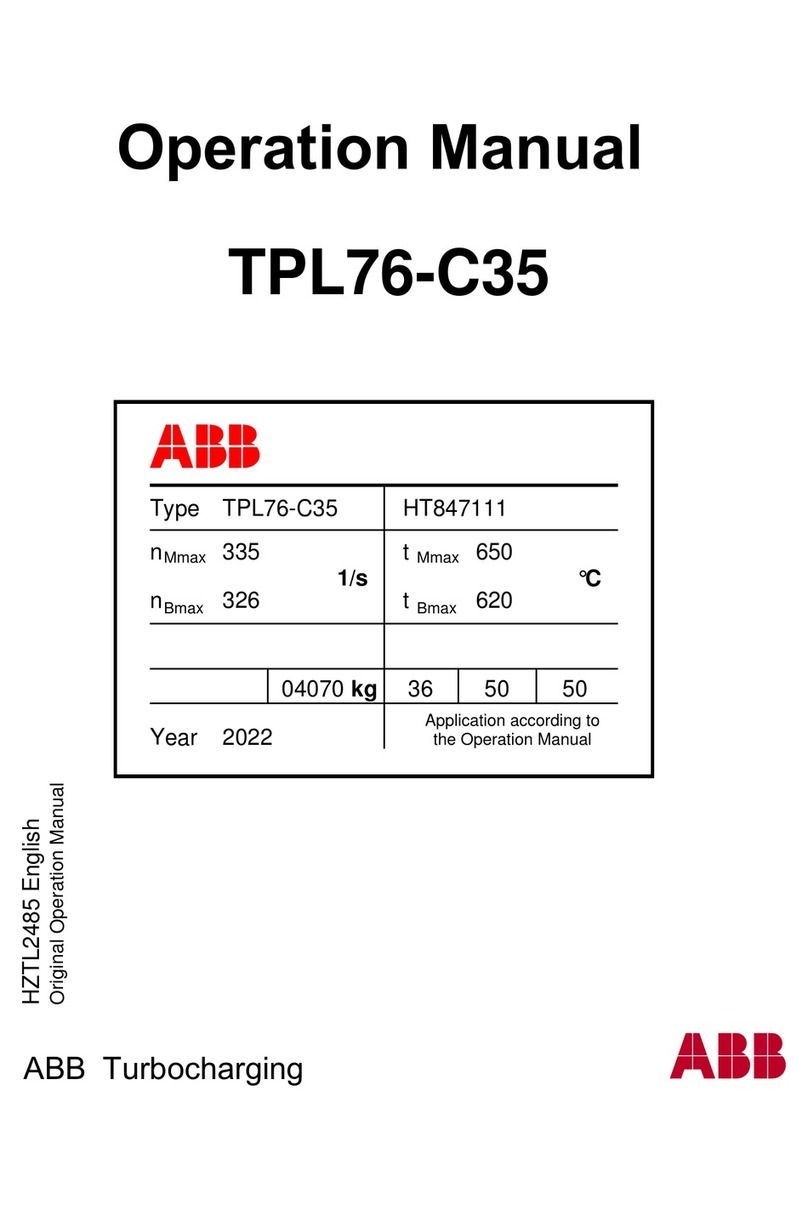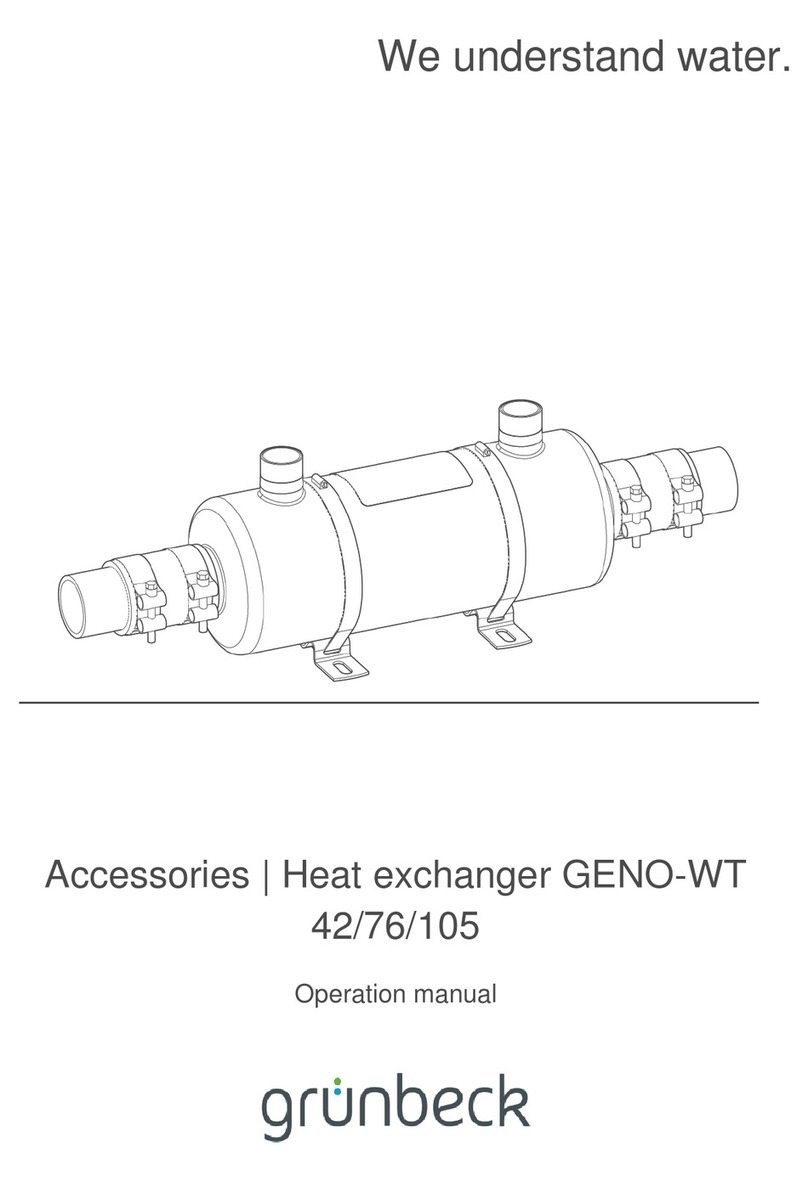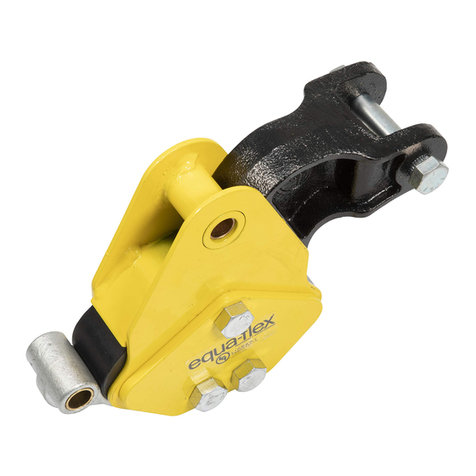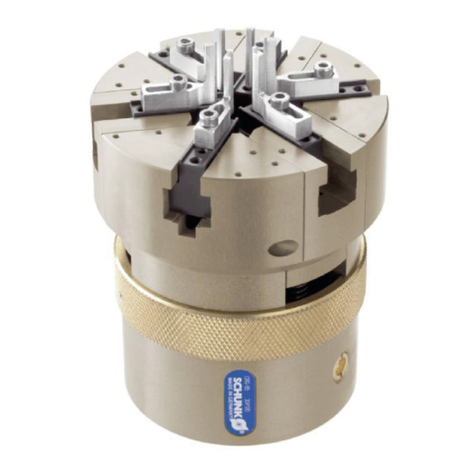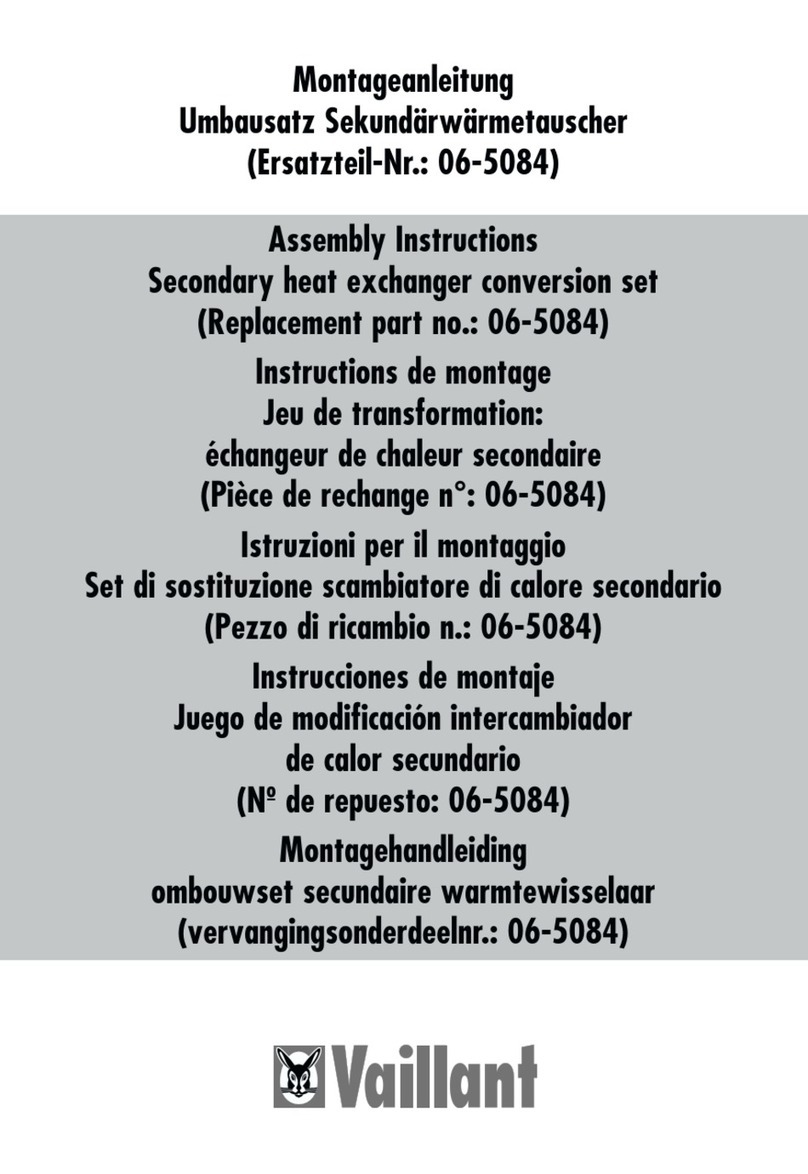Barnes 6DSE-L Series User manual

A Crane Co. Company
BARNES
BARNES®
INSTALLATION and OPERATION MANUAL
Submersible Dry Pit Sewage Ejector
IMPORTANT! Read all instructions in this manual before operating pump.
As a result of Crane Pumps & Systems, Inc., constant product improvement program,
product changes may occur. As such Crane Pumps & Systems reserves the right to
change product without prior written notification.
420 Third Street 83 West Drive, Bramton
Piqua, Ohio 45356 Ontario, Canada L6T 2J6
Phone: (937) 778-8947 Phone: (905) 457-6223
Fax: (937) 773-7157 Fax: (905) 457-2650
www.cranepumps.com Form No. 103701-Rev. G
Series: 6DSE-L, 1150RPM
Series: 6DSE-L, 1750RPM
CAUTION ! Pumps build up heat and
pressure during operation-allow time for
pumps to cool before handling or servicing.
Manual Index

2
TABLE OF CONTENTS
SAFETY FIRST............................................................................................... 3
A. PUMP SPECIFICATIONS................................................................................4 - 5
B. GENERAL INFORMATION..............................................................................6
C. INSTALLATION................................................................................................6 - 7
ELECTRICAL DATA.........................................................................................7
D. START-UP OPERATION..................................................................................7
E. PREVENTATIVE MAINTENANCE...................................................................7
F. SERVICE and REPAIR....................................................................................8 - 11
G. REPLACEMENT PARTS..................................................................................12
TROUBLE SHOOTING....................................................................................13
CROSS-SECTION (Fig. 7)...............................................................................14
EXPLODED VIEW (Fig. 8 & 9).........................................................................15 - 16
PARTS LIST ...................................................................................................17 - 19
RETURNED GOODS POLICY.........................................................................16
WARRANT ...................................................................................................20
START-UP REPORT........................................................................................21 - 22
WARRANTY REGISTRATION
SPECIAL TOOLS AND EQUIPMENT
INSULATION TESTER (MEGGER)
DIELECTRIC TESTER
SEAL TOOL KIT ( see parts list)
PRESSURE GAUGE KIT (see parts list)
Other brand and product names are trademarks or registered trademarks of their respective holders.
® Barnes is a registered trademark of Crane Pumps & Systems, Inc
2002, 4/05, 4/06, 9/06 Alteration Rights Reserved

3
Please Read This Before Installing Or Operating Pump.
This information is provided for SAFETY and to PREVENT
EQUIPMENT PROBLEMS. To help recognize this information,
observe the following symbols:
IMPORTANT! Warns about hazards that can result
in personal injury or Indicates factors concerned with
assembly, installation, operation, or maintenance which
could result in damage to the machine or equipment if
ignored.
CAUTION ! Warns about hazards that can or will cause minor
personal injury or property damage if ignored. Used with symbols
below.
WARNING ! Warns about hazards that can or will cause serious
personal injury, death, or major property damage if ignored. Used
with symbols below.
Only qualified personnel should install, operate and repair
pump. Any wiring of pumps should be performed by a qualified
electrician.
WARNING ! - To reduce risk of electrical shock, pumps
and control panels must be properly grounded in
accordance with the National Electric Code (NEC) or the
Canadian Electrical Code (CEC) and all applicable state,
province, local codes and ordinances.
WARNING! - To reduce risk of electrical shock, always
disconnect the pump from the power source before
handling or servicing. Lock out power and tag.
WARNING! Operation against a closed
discharge valve will cause premature bearing
and seal failure on any pump, and on end
suction and self priming pump the heat build
may cause the generation of steam with resulting dangerous
pressures. It is recommended that a high case temperature
switch or pressure relief valve be installed on the pump body.
CAUTION ! Never operate a pump with a plug-in type
power cord without a ground fault circuit interrupter.
CAUTION! Pumps build up heat and pressure
during operation-allow time for pumps to cool
before handling or servicing.
WARNING! - DO NOT pump hazardous materials
(flammable, caustic, etc.) unless the pump is specifically
designed and designated to handle them.
Do not block or restrict discharge hose, as discharge
hose may whip under pressure.
WARNING! - DO NOT wear loose clothing that may
become entangled in the impeller or other moving parts.
WARNING! - Keep clear of suction and discharge
openings. DO NOT insert fingers in pump with power
connected.
Always wear eye protection when working on pumps.
Make sure lifting handles are securely fastened each
time before lifting. DO NOT operate pump without
safety devices in place. Always replace safety devices
that have been removed during service or repair.
Secure the pump in its operating position so it can not
tip over, fall or slide.
DO NOT exceed manufacturers recommendation for
maximum performance, as this could cause the motor
to overheat.
DO NOT remove cord and strain relief. Do not connect
conduit to pump.
WARNING! Cable should be protected at all times to
avoid punctures, cut, bruises and abrasions - inspect
frequently. Never handle connected power cords with
wet hands.
WARNING! To reduce risk of electrical shock, all wiring
and junction connections should be made per the NEC
or CEC and applicable state or province and local
codes. Requirements may vary depending on usage
and location.
WARNING! Submersible Pumps are not approved for
use in swimming pools, recreational water installations,
decorative fountains or any installation where human
contact with the pumped fluid is common.
WARNING! Products Returned Must Be Cleaned,
Sanitized, Or Decontaminated As Necessary Prior
To Shipment, To Insure That Employees Will Not Be
Exposed To Health Hazards In Handling Said Material.
All Applicable Laws And Regulations Shall Apply.
Bronze/brass and bronze/brass fitted pumps may
contain lead levels higher than considered safe for
potable water systems. Lead is known to cause cancer
and birth defects or other reproductive harm. Various
government agencies have determined that leaded
copper alloys should not be used in potable water
applications. For non-leaded copper alloy materials of
construction, please contact factory.
IMPORTANT! - Crane Pumps & Systems, Inc. is not
responsible for losses, injury, or death resulting from a
failure to observe these safety precautions, misuse or
abuse of pumps or equipment.
SAFETY FIRST!
Hazardous fluids can
cause fire or explo-
sions, burnes or death
could result.
Extremely hot - Severe
burnes can occur on contact.
Biohazard can cause
serious personal injury.
Hazardous fluids can Hazard-
ous pressure, eruptions or ex-
plosions could cause personal
injury or property damage.
Rotating machinery
Amputation or severe
laceration can result. Hazardous voltage can
shock, burn or cause death.

4
PUMP DISCHARGE....... 6” 125lb, Horizontal
PUMP SUCTION............ 6” 125lb, Flange w/ 6” (152mm)
Cleanout
LIQUID TEMPERATURE. 104°F (40°C) Continuous
BASE ELBOW............... Cast Iron ASTM A-48, Class 30
MOTOR HOUSING ........ Cast Iron ASTMA-48, Class 30
VOLUTE......................... Cast Iron ASTM A-48, Class 30
SEAL PLATE ................. Cast Iron ASTM A-48, Class 30
IMPELLER:
Design...........Single Vane (2 Vane on 48 - 75HP),
Open with Pump out vanes on
Back side. Dynamically balanced,
ISO G6.3
Material ........ Cast Iron ASTM A-48, Class 30
SHAFT............................ 416 Stainless Steel
SQUARE RINGS............ Buna-N
DIAPHRAGM ................. Buna-N
HARDWARE .................. 300 Series Stainless Steel
PAINT............................. Air dry enamel
SEAL Design.......... Double Mechanical in oil filled
pressure equalized reservoir
Material ........ Rotating Faces - Carbon
Stationary Faces - Ceramic
Elastomer - Buna-N
Hardware - 300 series stainless steel
CORD ENTRY................ 25 Ft. (7.6m) Cord, Epoxy sealed
housing with secondary pressure
grommet for sealing and strain relief
SPEED ........................... 1150 & 1750 RPM, 60Hz (nominal)
UPPER BEARING:
Design.......... Single Row, Ball, Oil Lubricated
Load............. Radial
LOWER BEARING:
Design.......... Double Row, Ball, Oil Lubricated
Load............. Radial & Thrust
MOTOR: Design.......... NEMAB, Three Phase Torque Curve,
Oil Filled, Squirrel Cage Induction
Insulation...... Class F
THREE PHASE..............200-240/480 is Tri voltage motor.
Requires overload protection
to be included in control panel
MOISTURE SENSOR ....N/O, Requires relay in control panel
TEMP. SENSOR.............N/C, Requires relay in control panel
OPTIONAL EQUIPMENT..Seal Material, Impeller Trims,
Additional Cord,
SECTION: A - PUMP SPECIFICATIONS:

5
inches
(mm)

6
SECTION B: GENERAL INFORMATION
B-1) To the Purchaser:
Congratulations! You are the owner of one of the finest pumps
on the market today. CP&S pumps are products engineered
and manufactured of high quality components. Over one
hundred years of pump building experience along with a
continuing quality assurance program combine to produce a
pump which will stand up to the toughest applications. This
manual will provide helpful information concerning installation,
maintenance, and proper service guidelines.
B-2) Receiving:
Upon receiving the pump, it should be inspected for damage
or shortages. If damage has occurred, file a claim immediately
with the company that delivered the pump. If the manual
is removed from the packaging, do not lose or misplace.
B-3) Storage:
Short Term- CP&S Pumps are manufactured for efficient
performance following short inoperative periods in storage.
For best results, pumps can be retained in storage, as factory
assembled, in a dry atmosphere with constant temperatures
for up to six (6) months. Long Term- Any length of time
exceeding six (6) months, but not more than twenty-four (24)
months. The unit should be stored in a temperature controlled
area, a roofed over walled enclosure that provides protection
from the elements (rain, snow, wind-blown dust, etc.), and
whose temperature can be maintained between +40 deg. F
and +120 deg. F. (4.4 - 49°C). Pump should be stored in its
original shipping container. On initial start up, rotate impeller
by hand to assure seal and impeller rotate freely. If it is
required that the pump be installed and tested before the long
term storage begins, such installation will be allowed provided:
1.) The pump is not installed under water for more than
one (1) month.
2.) Immediately upon satisfactory completion of the test,
the pump is removed, thoroughly dried, repacked in the
original shipping container, and placed in a temperature
controlled storage area.
B-4) Service Centers:
For the location of the nearest Barnes Service Center, check
your Barnes representative or Crane Pumps & Systems, Inc.,
Service Department in Piqua, Ohio, telephone (937) 778-8947
or Crane Pumps & Systems Canada, in Brampton, Ontario,
(905) 457-6223.
SECTION C: INSTALLATION
C-1) Location:
These pumping units are self-contained and are recommended
for use in a sump, lift station or basin. This pump is designed
to pump sewage, effluent, or other nonexplosive or noncor-
rosive wastewater and shall NOT be installed in locations
classified as hazardous in accordance with the National
Electrical Code (NEC), ANSI/NFPA 70 or Canadian Electrical
Code. Never install the pump in a trench, ditch or hole with a
dirt bottom; the legs will sink into the dirt and the suction will
become plugged.
C-2) Discharge:
Discharge piping should be as short as possible. Both a
check valve and a shut-off valve are recommended for each
pump being used. The check valve is used to prevent back-
flow into the sump. Excessive backflow can cause flooding
and/or damage to the pump. The shut-off valve is used to
stop system flow during pump or check valve servicing.
C-3) Liquid Level Controls:
The level controls are to be supported by a mounting bracket
that is attached to the sump wall, cover or junction box. Cord
grips are used to hold the cords in place on the mounting
bracket. The control level can be changed by loosening the
grip and adjusting the cord length as per the plans and speci-
fications. Be certain that the level controls cannot hang up or
foul in it’s swing and that the pump is completely submerged
when the level control is in the “Off” mode.
C-4) Electrical Connections:
C-4.1) Power & Control Cords:
The cord assembly mounted to the pump must not be modi-
fied in any way except for shortening to a specific application.
Any splice between the pump and the control panel must be
made in accordance with all applicable electric codes. It is
recommended that a junction box, if used, be mounted out-
side the sump or be of at least Nema 4 (EEMAC-4) construc-
tion if located within the wet well. DO NOT USE THE POWER
OR CONTROL CORDS TO LIFT PUMP.
NOTE: The White Wire Is Not A Neutral Or Ground Lead.
The Black, White And Red Leads Are Power Carrying
Conductors. The Green Lead Is For Connection To
Ground.
C-4.2) Overload Protection :
Three Phase - The normally closed (N/C) thermal sensor is
embedded in the motor windings and will detect excessive
heat in the event an overload condition occurs. The thermal
sensor will trip when the windings become too hot and will
automatically reset itself when the pump motor cools to a
safe temperature. It is recommended that the thermal sensor
be connected in series to an alarm device to alert the opera-
tor of an overload condition, and/or the motor starter coil to
stop the pump. In the event of an overload, the source of this
condition should be determined and rectified immediately. DO
NOT LET THE PUMP CYCLE OR RUN IF AN OVERLOAD
CONDITION OCCURS !
C-4.3) Moisture Sensors:
A normally open (N/O) detector is installed in the pump seal
chamber which will detect any moisture present. It is recom-
mended that this detector be connected in series to an alarm
device or the motor starter coil to alert the operator that a
moisture detect has occurred. In the event of a moisture
detect, check the individual moisture sensor probe leads for
continuity, ( ∞resistance = no moisture ) and the junction
box/control box for moisture content. The above situations
may induce a false signal in the moisture detecting circuit. If
none of the above test prove conclusive, the pump(s) should
be pulled and the source of the failure identified and repaired.
IF A MOISTURE DETECT HAS OCCURRED SCHEDULE
MAINTENANCE AS SOON AS POSSIBLE.

7
TEMPERATURE SENSOR ELECTRICAL RATINGS
Volts Continuous
Amperes Inrush
Amperes
110-120 3.00 30.0
220-240 1.50 15.0
440-480 0.75 7.5
600 0.60 6.0
C-4.4) Wire Size:
Consult a qualified electrician for proper wire size if additional
power cable is required. See table for electrical information.
SECTION: D START-UP OPERATION
D-1) Check Voltage and Phase:
Before operating pump, compare the voltage and phase
information stamped on the pump identification plate to the
available power.
D-2) Check Pump Rotation:
Before putting pump into service for the first time, the motor
rotation must be checked. Improper motor rotation can result
in poor pump performance and can damage the motor and/or
pump. To check the rotation, suspend the pump freely, mo-
mentarily apply power and observe the “kickback”. “Kickback”
should always be in a counter-clockwise direction as viewed
from the top of the pump motor housing.
D-2.1) Incorrect Rotation for Three-Phase Pumps:
In the event that the rotation is incorrect for a three-phase
installation, interchange any two power cable leads at the
control box. DO NOT change leads in the cable housing in
the motor. Recheck the “kickback” rotation again by momen-
tarily applying power.
D-2.2) Incorrect Rotation for Single-Phase Pumps:
In the unlikely event that the rotation is incorrect for a single
phase pump, contact a Barnes Service Center.
D-3) Start-Up Report:
Included at the end of this manual is a start-up report sheet,
this sheet is to be completed as applicable. Return one copy
to Barnes and store the second in the control panel or with
the pump manual if no control panel is used. It is important to
record this data at initial start-up since it will be useful to refer
to should servicing the pump be required in the future.
D-3.1) Identification Plate:
Record the numbers from the pump identification plate on
both START-UP REPORTS provided at the end of the manual
for future reference.
D-3.2) Insulation Test:
Before the pump is put into service, an insulation (megger)
test should be performed on the motor. The resistance values
(ohms) as well as the voltage (volts) and current (amps)
should be recorded on the start-up report.
D-3.3) Pump-Down Test:
After the pump has been properly wired and lowered into the
basin, sump or lift station, it is advisable to check the system
by filling with liquid and allowing the pump to operate through
its pumping cycle. The time needed to empty the system, or
pump-down time along with the volume of water, should be
recorded on the start-up report.
SECTION E: PREVENTATIVE MAINTENANCE
As the motor is oil filled, no lubrication or other maintenance
is required, and generally Crane Pumps & Systems will give
very reliable service and can be expected to operate for years
on normal sewage pumping without failing. However as with
any mechanical piece of equipment a preventive mainte-
nance program is recommended and suggested to include
the following checks:
1) Inspect motor and seal chambers for oil level and
contamination and repair as required per section F-1.
2) Inspect impeller and body for excessive build-up or
clogging and repair as required per section F-2.
3) Inspect motor and bearings and replace as required per
section F-3.
4) Inspect seal and diaphragm for wear or leakage and
repair as required per section F-4.
5) Inspect suction elbow cleanout for excessive build-up or
clogging, service per section F-5.
MODEL
NO HP VOLT PH RPM
(Nom) NEMA
START
CODE
FULL
LOAD
AMPS
LOCKED
ROTOR
AMPS
CORD
SIZE CODE
TYPE CORD
O.D.
± .02 (.5)
in (mm)
WINDING
RESISTANCE
6DSE8096L 8 200-230 3 1150 F 29.9/26 140.8/162 6/3-3G G 1.010 0.445
6DSE8046L 8 460 3 1150 J 13.0 81.0 6/3-3G G 1.010 1.780
6DSE10096L 10 200-230 3 1150 D 41.4/36 140.8/162 6/3-3G G 1.010 0.445
6DSE10046L 10 460 3 1150 F 18.0 81.0 6/3-3G G 1.010 1.780
6DSE12096L 12 200-230 3 1150 C 57.5/50 201.7/232 6/3-3G G 1.010 0.080
6DSE12046L 12 460 3 1150 F 25.0 116.0 6/3-3G G 1.010 0.320
6DSE16096L 16 200-230 3 1150 C 73.6/64 252.1/290 6/3-3G G 1.010 0.235
6DSE16046L 16 460 3 1150 E 32.0 145.0 6/3-3G G 1.010 0.940
6DSE20096L 20 200-230 3 1150 C 94.3/82 316.5/364 2/3-3G G 1.340 0.123
6DSE20046L 20 460 3 1150 E 41.0 182.0 2/3-3G G 1.340 0.490
6DSE60044L 60 460 3 1750 E 78.0 363.0 2/3-3G G 1.340 0.310
Winding Resistance ± 5%, measured from terminal block.
Pump rated for operation at ± 10% voltage at motor.
Moisture & Temperature sensor cord for ALLmodels is 18/5 SOW, 0.476 (12) ± .02 O.D.

8
SECTION F: SERVICE AND REPAIR
NOTE: All item numbers in ( ) refer to Figures 7, 8 and 9.
CAUTION ! - Before servicing and/or
removing pump from system, verify that the pip-
ing system has no pressure.
F-1) Lubrication:
Anytime the pump is removed from operation the cooling oil
in the motor housing (2) and seal chamber, must be checked
visually for oil level and contamination.
F-1.1) Checking Oil:
Motor Housing - To check oil, set unit upright. Remove cap
screws (6), lift conduit box assembly (10) from motor housing
(2) but DO NOT disconnect conduit box wiring from motor
leads. With a flashlight, visually inspect the oil in the motor
housing (2) to make sure it is clean, clear and that oil level is
above all internal componentry.
Seal Chamber - Place pump on its side with the square head
pipe plug (22) downward (180° from discharge on bearing
bracket (21), remove pipe plug (22) and drain oil from the
seal chamber. If the oil is found to contain considerable water
or other contamination or little oil drains out, the shaft seal
(46) and diaphragm (32) should be inspected and replaced if
required.
F-1.2) Testing Oil:
1. Place pump on it’s side, remove cap screws (6), lift
conduit box assembly (10) from motor housing (2) and
drain oil into a clean, dry container. In separate container
drain seal chamber by removing pipe plug (22).
2. Check oil for contamination using an oil tester with a
range to 30 Kilovolts breakdown.
3. If oil is found to be clean and uncontaminated (measure
above 15 KV. breakdown), refill the motor housing and
seal chamber as per section F-1.3.
4. If oil is found to be dirty or contaminated (or measures
below 15 KV. breakdown), the the pump must be
carefully inspected for leaks at the shaft seal (46),
conduit box assembly (10), diaphragm (32), O-ring (42),
pipe plugs (22) and (45) and pressure valve (5) before
refilling with oil. To locate the leak, perform a pressure
test as per section F-1.4. After leak is repaired, refill with
new oil as per section F-1.3.
F-1.3) Replacing Oil:
Motor Housing - Drain all oil from motor housing and dis-
pose of properly. Refill with (see parts list for amount) new
cooling oil as per Table 1. An air space must remain in the top
of the motor housing to compensate for oil expansion (see
Fig. 8). Set unit upright and fill only until the motor, as viewed
through the conduit box opening, is just covered and no
more. Reassemble the O-ring (11), conduit box assembly (10)
and cap screws (6), apply thread locking compound to each
cap screw (6) thread before installing. Torque cap screws (6)
to 15 ft., lb.
Seal Chamber - Refill chamber completely full with new cool-
ing oil per Table 1 or reuse the uncontaminated oil. (See parts
list for amount.)
Important! - Do not overfill oil!
Overfilling of motor housing with oil can cre-
ate excessive and dangerous hydraulic
pressure which can destroy the pump and
create a hazard. Overfilling oil voids warranty.
TABLE 1 - COOLING OIL - Dielectric
SUPPLIER GRADE
BP Enerpar SE100
Conoco Pale Paraffin 22
Mobile D.T.E. Oil Light
G & G Oil Circulating 22
Imperial Oil Voltesso-35
Shell Canada Transformer-10
Texaco Diala-Oil-AX
Woco Premium 100
Caution! - Pressure builds up extremely
fast, increase pressure by “tapping” air
nozzle. Too much pressure will damage
seal. Do Not exceed 10 P.S.I. in motor
housing & 20-25 P.S.I. in seal chamber.
F-1.4) Pressure Test:
Motor Housing - Before checking the pump for leaks around
the shaft seal, square rings, and cord inlet, the oil level should
be full as described in section F-1.3. Remove pressure valve
(5) from motor housing (2). Apply pipe sealant to pressure
gauge assembly and tighten into pressure valve hole (See
Fig. 1). Pressurize motor housing to 10 P.S.I. Use a soap
solution around the sealed areas and inspect joints for “air
bubbles”. If, after five minutes, the pressure is still holding
constant, and no “bubbles” are observed, slowly bleed the
pressure and remove the gauge assembly. Replace the Pres-
sure valve using a sealant. If the pressure does not hold, then
the leak must be located.
Seal Chamber - Remove pipe plug (22) from Bearing Bracket
(21) and check that seal chamber is full of oil. Apply pipe
sealant to pressure gauge assembly and tighten into hole in
bearing bracket (21). Pressurize seal chamber to 20-25 PSI
and check for leaks as outlined above.
FIGURE 1

9
F-2) Impeller and Volute Service:
F-2.1) Disassembly and Inspection:
To clean out volute (26) or replace impeller (28), or replace
wear ring (31), disconnect power, remove hex nuts (20) and
vertically lift motor and seal assembly from body (26). Clean
out body if necessary. Clean and examine impeller (28), for
pitting or wear and replace if required, inspect gasket (41) and
replace if cut or damaged. If the impeller (28) requires replac-
ing, remove cap screw (34) and washer (35). The impeller is
keyed onto the shaft with a square key (33) and to remove, pull
impeller straight off the shaft using a wheel puller, if required. If
the wear ring (31) require replacing, split the wear ring (31) and
remove, be careful not to damage the volute. Before reinstall-
ing, check the motor shaft and impeller bore for damage.
F-2.2) Reassembly:
To install wear ring (31) first apply retaining compound to the
bore of body (26) and then press wear ring (31) into bore of
body (26) until seated. To install impeller (28), apply a thin
film of oil to motor shaft and slide impeller straight onto shaft,
keeping keyways lined up. Drive key (33) into keyway. Locate
washer (35), apply thread lock primer (such as Loctite®
Primer T) let set per manufactures’ directions. Apply thread
locking compound to cap screw (34) threads, thread cap
screw (34) into shaft and torque to 35 ft. lb. Rotate impeller to
check for binding. Position gasket (41) on volute flange and
install impeller and motor housing over studs and onto volute
(26). Apply thread locking compound to threads of each stud
(24). Thread nut (20) onto stud (24) and torque to 24 ft. lb.
Check for free rotation of motor and impeller.
F-3) Motor and Bearing Service
F-3.1) Disassembly and Inspection:
To examine or replace the motor (1) and bearings (3) and
(47), disassemble pump, volute and impeller (as outlined in
paragraph F-2.1) and disassemble seal plate and shaft seal
(as outlined in paragraph F-4.1). Drain oil from motor as out-
lined in paragraph F-1.3.
Position unit upright, using blocks to avoid resting unit on shaft.
After removal of cable and box assembly (10) from motor
housing (2), remove cable lead wires from motor lead wires
and moisture and temperature sensors wires (if equipped)
from control cable by unscrewing connectors (12) and (17).
The wiring connections should be noted to insure correct con-
nections when reassembling. Remove cap screws (19) and
hex nuts (20). Vertically lift the outside motor housing (2) from
bearing bracket (21) with lifting strap (7). Inspect square ring
(42) for damage or cuts. Remove the upper motor bolts and lift
upper end bell from motor (1). Examine upper bearing (3) and
replace if required. If replacement is required, remove bearing
(3) from motor shaft using a wheel puller.
Vertically lift stator. Inspect winding for shorts and resistance.
To test the temperature sensor (if equipped), check for continu-
ity between the black and white wires. If found to be defective
contact a motor service station or Crane Pumps & Systems
service department. Pull motor rotor and lower bearing (47)
vertically from bearing bracket (21). Examine bearing (47) and
replace if required. If replacement is required, remove bear-
ing (47) from motor shaft using a wheel puller. Check rotor for
wear. If rotor or the stator windings are defective, the complete
motor must be replaced. While disassembled, check moisture
sensor wires (16), (if equipped) that they are secured to elec-
trodes (18) with lockwashers (15) and screws (14).
Important !
All parts must be clean before reassembly.
F-3.2) Reassembly:
Bearings - When replacing bearings, be careful not to
damage the rotor or shaft threads. (If so equipped, fill notch
should face the rotor core for both upper and lower bearings).
Clean the shaft thoroughly. Apply adhesive compound to
the shaft and press bearing (47) on the motor shaft, position
squarely onto the shaft applying force to the inner race of the
bearing only, until bearing seats against shoulder of the shaft.
Reassemble top bearing (3) in the same manner.
Motor - Slide lower bearing (47) and motor rotor squarely into
the bearing bracket (21) until bearing seats on the bottom.
Position motor housing and stator into pilot, aligning studs
(37) with holes in bearing bracket (21). Apply thread locking
compound on studs (37) and position washers (36) and nuts
(38) on studs (37) and torque to 18 ft. lbs. Position upper mo-
tor end bell aligning holes and thread cap screws into motor.
Torque to 16 ft. lbs. Place all motor leads above the motor.
Position square ring (42) over bearing bracket (21) and lower
housing (2) over motor and into pilot. Apply thread locking
compound to cap screws (19) threads and install with nut (20).
Torque to 24 ft. lb.
F-4) Shaft Seal and Diaphragm Service:
Important! - Handle seal parts with extreme care.
do not scratch or mar lapped surfaces.
F-4.1) Disassembly and Inspection:
Diaphragm - To examine or replace the diaphragm (32) or
shaft seal (46), remove impeller (28) as outlined in paragraph
F-2.1. Drain oil from seal chamber as outlined in paragraph
F-1.3. Remove cap screws (8), washers (9) and lifting strap
(7). Set unit upside down on blocks to avoid damaging cords.
Remove socket head cap screws (39) and lift seal plate (25)
vertically, being cautious to avoid seal damage, together with
diaphragm (32), clamp (43) and outboard stationary member
(46A) of shaft seal (46), from bearing bracket (21). Examine
diaphragm (32), if it is ruptured, cracked or damaged, replace
by removing screws (44) and diaphragm clamp (43), Also,
clean out vent holes in seal plate (25). Check moisture sensor
probes (18) for damage. Replace by disconnecting wires (16)
by removing screws (14) and lockwashers (15). Then remove
probe (18) from bearing bracket (21).
Seal - To expose shaft seal (46) for examination, complete
above procedure and slide off outboard rotating member (46B),
See Figure 2. Remove inboard rotating member (46D), from
shaft. Examine all seal parts and especially contact faces.
Inspect seal for signs of wear such as uneven wear pattern on
stationary members, chips and scratches on either seal face.
DO NOT interchange seal components, replace the entire
shaft seal (46).
F-4.2) Reassembly:
Diaphragm - At reassembly, make sure the bulge and molded-
in part number of diaphragm (32) is facing the seal plate (25).
With diaphragm (32) in place, lay diaphragm clamp (43) in
place on seal plate (25) and insert the four cap screws (44)
and tighten. Apply pipe thread compound to moisture sensor
probe (18), and insert in bearing bracket (21). Attach wires
(16) with lockwashers (15) and screws (14).

10
Seal - Clean and oil seal cavities in bearing bracket (21)
and seal plate (25). Lightly oil (DO NOT use grease) outer
surface of inboard stationary member (46E) and outboard
stationary member (46A). Press inboard stationary member
(46E) firmly into bearing bracket (21) and outboard stationary
(46A) into seal plate (25), using a seal pusher (see parts list-
seal tool kit), nothing but the seal pusher is to come in contact
with seal face (See Figures 2 & 3).
Important ! - DO NOT hammer on the seal pusher-
it will damage the seal face.
Make sure the stationary members are in straight and that
the rubber ring is not out of it’s groove. Lightly oil (DO NOT
use grease) shaft and inner surface of bellows on rotating
member (46D) See Figure 4. With lapped surface facing
bearing bracket (21), slide rotating member (46D) onto shaft,
using seal pusher, until lapped faces of (46D) and (46E) are
together (See Figure 2). It is extremely important to keep seal
faces clean during assembly. Dirt particles lodged between
these faces will cause the seal to leak.
Make sure driving lugs in retainer are matched in rotating
member. Place spring (46C) over shaft and in place on rotat-
ing member (4E), making sure it is seated in retainer and not
cocked or resting on bellows tail. Re-oil shaft and lightly oil
inner surface of outboard rotating member (46B). With tail
section toward bearing bracket (21), slide rotating member
(46B) onto shaft with seal pusher until retainer engages spring
(46C) and spring is compressed slightly. Make sure spring
(46C) is properly engaged in both retainers. Insert o-ring (42)
onto bearing braket (21). Slide seal plate (25) over shaft onto
bearing bracket (21), being careful not to damage outboard
stationary member (46A) and align holes for socket head cap
screws (39). Thread socket head cap screws (39) into bearing
bracket (21) and tighten. Fill seal chamber with oil as outlined
in paragraph F-1.3. Reassemble impeller and volute per para-
graph F-2.2.
F-4.3) Wiring Connections:
Check power cable (10A) and control cable (10D), on conduit
box (10), for cracks or damage and replace complete conduit
box assembly (10) if required (See Fig. 5). Bring motor wires
through wire opening in top of housing (2),check sleeving (53)
and replace if required, position square ring (11) in conduit
housing (10) and reconnect motor leads to power cable and
moisture and temperature sensor leads to control cable using
connectors (12), (17) and insulators (54) as show in Figure 6.
F-4.4) Conduit Box and Cable Assembly:
Refill with cooling oil as outlined in paragraph F-1.3. Position
conduit box (10) and square ring (11) over opening, apply
thread locking compound to cap screws (6) threads and torque
to 16 ft. lb. Remove gland nuts (10B) and (10F), friction rings
(10C) and (10G), and grommets (10D) and (10H) from conduit
box (10) inspect and replace if required (See Figure 5). Insert
one friction ring (10C), grommet (10D), one friction ring (10C)
and gland nut (10B) into conduit box for power cable (10A). For
control cable (10E), insert grommet (10H), friction ring (10G)
and gland nut (10F). Torque gland nuts (10B) and (10F) to 15
ft. lb. to prevent water leakage.
F-5) Base & Elbow Service:
To clean out base elbow (68) remove cap screws, clean-out
plates (64) and o-ring (67) from elbow (68). Inspect o-ring
and replace if damaged. If gasket (58) is damaged or leaking,
remove hex nuts (61) and lockwashers (60) and remove hard-
ware from piping to drop elbow down. To remove pump from
base (59) remove hex nuts (70) and lockwashers (66) and lift
pump from base.
FIGURE 2
FIGURE 4
Stationary Member (46E)
Polished Face Out
Seal Plate (25) Seal Pusher
FIGURE 3
Rotating Member (46D)
Bullet
Motor & Bearing Bracket
Seal Pusher
Stationary

11
Reassemble by placing pump assembly on base (59) and as-
semble lockwashers (66) and hex nuts (70) through base and
into pump body. Place gasket (58) onto base (59) and elbow
(68). Assemble lockwashers (60) and hex nuts (61) through
elbow into pump and tighten evenly.
THREE PHASE 200-240 VOLT AC
THREE PHASE 200-240 VOLT AC
Power Cable
Power Cable
Motor Lead Number
Motor Lead Number
Green (3-Ground)* Green
Black 1 & 7
Red 2 & 8
White 3 & 9
T4, T5 & T6 Together
(*) Ground wires could be either 3 Green, or 1 Green and 2
Yellow or 2 Green and 1 Yellow.
THREE PHASE 480-600 VOLT AC
THREE PHASE 480-600 VOLT AC
Power Cable
Power Cable
Motor Lead Number
Motor Lead Number
Green (3-Ground)* Green
Black 1
Red 2
White 3
T4 & T7 Together
T5 & T8 Together
T6 & T9 Together
MOISTURE AND TEMPERATURE SENSORS
MOISTURE AND TEMPERATURE SENSORS
Control Cable
Control Cable
Lead Number
Lead Number
Green (Ground) Green
Black P1 (Temperature Sensor)
White P2 (Temperature Sensor)
Red W1 (Moisture Sensor)
Orange W2 (Moisture Sensor)
FIGURE 6
Friction
Ring
(49C)
FIGURE 5
Gland Nut (49B)
Power Cable (49A)
Friction Ring
(49C)
Grommet
(49D)
Conduit Box
& Cable
Assembly
(49)
Friction Ring
(49G)
Grommet
(49H)
Friction
Ring
(49G)
Gland Nut (49F)
Control
Cable
(49E)

12
SECTION: G REPLACEMENT PARTS
G-1 ORDERING REPLACEMENT PARTS:
When ordering replacement parts, ALWAYS furnish the follow-
ing information:
1. Pump serial number and date code. (Paragraph G-4)
2. Pump model number. (Paragraph G-3)
3. Pump part number. (Paragraph G-2)
4. Part description.
5. Item part number.
6. Quantity required.
7. Shipping instructions.
8. Billing Instructions.
G-2 PART NUMBER:
The part number consists of a six (6) digit number, which ap-
pears in the catalog. Aone or two letter suffix may follow this
number to designate the design configuration. This number is
used for ordering and obtaining information.
G-3 MODEL NUMBER:
This designation consists of numbers and letters which rep-
resent the discharge size, series, horsepower, motor phase
and voltage, speed and pump design. This number is used for
ordering and obtaining information.
G-4 SERIAL NUMBER:
The serial number block will consist of a six digit number,
which is specific to each pump and may be preceded by a al-
pha character, which indicates the plant location. This number
will also be suffixed with a four digit number, which indicates
the date the unit was built (Date Code). EXAMPLE: A012345
0490.
Reference the six digit portion (Serial Number) of this number
when referring to the product.

13
TROUBLE SHOOTING
CAUTION ! Always disconnect the pump from the electrical power source before handling.
If the system fails to operate properly, carefully read instructions and perform maintenance recommendations.
If operating problems persist, the following chart may be of assistance in identifying and correcting them:
MATCH “CAUSE” NUMBER WITH CORRELATING “CORRECTION” NUMBER.
NOTE: Not all problems and corrections will apply to each pump model.
PROBLEM CAUSE CORRECTION
Pump will not run 1. Poor electrical connection, blown fuse,
tripped breaker or other interruption of power,
improper power supply.
2. Motor or switch inoperative (to isolate
cause, go to manual operation of pump).
2a. Float movement restricted.
2b. Switch will not activate pump or is defective.
2c. Defective motor
3. Insufficient liquid level.
1. Check all electrical connections for
security. Have electrician measure current
in motor leads, if current is within ±20%
of locked rotor Amps, impeller is probably
locked. If current is 0, overload may be
tripped. Remove power, allow pump to cool,
then recheck current.
2a. Reposition pump or clean basin as
required to provide adequate clearance for
float.
2b. Disconnect level control. Set ohmmeter
for a low range, such as 100 ohms full scale
and connect to level control leads. Actuate
level control manually and check to see that
ohmmeter shows zero ohms for closed switch
and full scale for open switch. (Float Switch).
2c. Check winding insulation (Megger Test)
and winding resistance. If check is outside
of range, dry and recheck. If still defective,
replace per service instructions.
3. Make sure liquid level is at least equal to
suggested turn-on point.
4. Recheck all sizing calculations to
determine proper pump size.
5. Check discharge line for restrictions,
including ice if line passes through or into
cold areas.
6. Remove and examine check valve for
proper installation and freedom of operation.
7. Open valve.
8. Check impeller for freedom of operation,
security and condition. Clean impeller and
inlet of any obstruction.
9. Loosen union slightly to allow trapped air
to escape.Verify that turn-off level of switch
is set so that the suction is always flooded.
Clean vent hole.
10. Check rotation. If power supply is three
phase, reverse any two of three power supply
leads to ensure proper impeller rotation..
11. Repair fixtures as required to eliminate
leakage.
12. Check pump temperature limits & fluid
temperature.
13. Replace portion of discharge pipe with
flexible connector.
14. Turn to automatic position.
15. Check for leaks around basin inlet and
outlets.
Pump will not turn off 2a. Float movement restricted.
2b. Switch will not activate pump or is defective.
4. Excessive inflow or pump not properly sized
for application.
9. Pump may be airlocked
14. H-O-Aswitch on panel is in “HAND” position
Pump hums but does not run 1. Incorrect voltage
8. Impeller jammed or loose on shaft, worn or
damaged, impeller cavity or inlet plugged.
Pump delivers insufficient capacity 1. Incorrect voltage.
4. Excessive inflow or pump not properly sized
for application.
5. Discharge restricted.
6. Check valve stuck closed or installed backwards.
7. Shut-off valve closed.
8. Impeller jammed or loose on shaft, worn or
damaged, impeller cavity or inlet plugged.
9. Pump may be airlocked.
10. Pump running backwards
Pump cycles too frequently or runs
periodically when fixtures are not in use 6. Check valve stuck closed or installed
backwards.
11. Fixtures are leaking.
15. Ground water entering basin.
Pump shuts off and turns on indepen-
dent of switch, (trips thermal overload
protector). CAUTION! Pump may start
unexpectedly. Disconnect power supply.
1. Incorrect voltage.
4. Excessive inflow or pump not properly sized
for application.
8. Impeller jammed, loose on shaft, worn or
damaged, impeller cavity or inlet plugged.
12. Excessive water temperature.
(internal protection only)
Pump operates noisily or vibrates
excessively 2c. Worn bearings, motor shaft bent.
5. Debris in impeller cavity or broken impeller
10. Pump running backwards
13. Piping attachments to buiding structure too
rigid or too loose.

14
FIGURE 7
6DSE-L Pump Series

15
FIGURE 8
6DSE-L Pump Series

16
FIGURE 9
RETURNED GOODS
RETURN OF MERCHANDISE REQUIRES A “RETURNED GOODS AUTHORIZATION”.
CONTACT YOUR LOCAL CRANE PUMPS & SYSTEMS, INC. DISTRIBUTOR.
Products Returned Must Be Cleaned, Sanitized,
Or Decontaminated As Necessary Prior To Shipment,
To Insure That Employees Will Not Be Exposed To Health
Hazards In Handling Said Material. All Applicable Laws
And Regulations Shall Apply.
IMPORTANT!
WARRANTY REGISTRATION
Your product is covered by the enclosed Warranty.
Complete the Warranty Registration Form and return to
Crane Pumps & Systems, Inc. Warranty Service Group
If you have a claim under the provision of the warranty, contact your local
Crane Pumps & Systems, Inc. Distributor.

17
6DSE-L Pump Series
PARTS KITS
Seal Repair Kit...........P/N-085205
Overhaul Kit...............P/N-085208
Seal Tool Kit...............P/N-085738
Pressure Gauge Kit...P/N-085343
PARTS LIST
ITEM QTY PART NO. DESCRIPTION
1 1 072361 Motor, 6DSE8096L
072361 6DSE8046L
072361 6DSE10096L
072361 6DSE10046L
072362 6DSE12096L
072362 6DSE12046L
072363 6DSE16096L
072363 6DSE16046L
072364 6DSE20096L
072364 6DSE20046L
072374 6DSE60044L
2 1 072295 Motor Housing
3 1 052358 Ball Bearing
4 1 070624 Pipe Closure
5 1 070623 Pressure Relief Valve
6 4 1-529-1 Cap Screw 3/8-16 x 1” lg Stainless
7 1 052214 Lifting Strap
8 2 1-92-1 Cap Screw 5/8-11 x 1-1/2” lg Stainless
9 2 038519 Washer 5/8 Stainless
10 1 See Table 2 Conduit Box & Cable Assembly
10a 1 ------ * Power Cable (Not Sold Separately)
10b 1 052259 * Gland Nut
10c 2 052288 * Friction Ring - 8,10,12,16HP - 1150RPM
10c 2 052261 * Friction Ring - 20Hp - 1150RPM & 60HP - 1750RPM
10d 1 052287 *Grommet - 8,10,12,16HP - 1150RPM
10d 1 052262 *Grommet - 20Hp - 1150RPM & 60HP - 1750RPM
10e 1 ------ * Control Cable (Not Sold Separately)
10f 1 051448 * Gland Nut
10g 1 021531 * Friction Ring
10h 1 066871 *Grommet
10J 1 030169 * Ground Screw 10-32 x 5/8 Lg Stainless
10k 4 029710 * Shrink Tube
10l 3 052291 *Connector - 8,10,12,16HP - 1150RPM
11 1 051937 Square Ring
12 5 030148 Connector - 8,10,12,16HP - 1150RPM
5 052290 Connector - 20Hp - 1150RPM & 60HP - 1750RPM
13 15 Gal. 029034 Oil - Motor Housing, 8-20HP
11 Gal. Motor Housing, 60HP
1-1/2 Qts. Seal Cavity
14 2 5-32-6 Machine Screw 6-32 x 1/4 Cad. Plt. Steel
15 2 052563 Lockwasher No. 6 Steel
16 2 051487 Moisture Sensor Wire
17 4 052990 Connector
18 2 039383 Electrode
19 6 053525 Cap Screw 7/16-14 x 2-1/4” lg Stainless
20 18 027116 Nut 7/16-14 Stainless
21 1 072330 Bearing Bracket, 8,10,12,16HP - 1150RPM
072331 Bearing Bracket, 20Hp - 1150RPM & 60HP - 1750RPM
22 1 003202 Pipe Plug
24 12 085513 Stud 7/16-14 x 2-1/4” lg Stainless
25 1 072593 Seal Plate
() 10d, 10h, 11, 32, 33, 34, 35, 41, 42, 46
() 3, 5, 10d, 10h, 10l, 11, 12, 16, 17, 18, 32, 33, 34, 35, 41, 42, 46, 47, 54
(*) Included with item number 10.

18
26 1 087410 Volute
27 2 039934 Caplug
28 1 See Table 3 Impeller, Cast Iron
31 1 084122 Wear Ring
32 1 052093 Diaphragm
33 1 053532 Shaft Key 3/8 Sq. x 1-3/4 lg. Stainless
34 1 11-102-1 Socket Head Screw 5/8-11 x 1-1/2” Lg. 18-8 Stainless
35 1 4588-SS Impeller Washer .656 x 1.812 Stainless
36 4 002603 Lockwasher, 5/16 Steel 8,10,12,16HP - 1150RPM
018926 Lockwasher, 3/8 Stainless 20Hp - 1150RPM & 60HP - 1750RPM
37 4 078660 Stud, 5/16-18 x 4-1/2” lg Steel 8,10,12,16HP - 1150RPM
084885 Stud, 3/8-16 x 4-1/2” lg Steel20Hp - 1150RPM & 60HP - 1750RPM
38 4 002501 Nut, 5/16-18 Steel 8,10,12,16HP - 1150RPM
028172 Nut, 3/8-16 Steel 20Hp - 1150RPM & 60HP - 1750RPM
39 4 036803 Soc. Hd. Cap Screw1/4-20 x 3/4” lg Stainless
41 1 051936 Gasket
42 2 052082 O-Ring
43 1 052206 Diaphragm Clamp Ring
44 4 002203 Cap Screw 1/4-20 x 7/8” lg Steel
45 1 022932 Hex Head Pipe Plug
46 1 051938 Shaft Seal (Both Ends) Carbon/Ceramic/Buna-N (STD)
060818 (Pump End) Tungsten/Carbide/Buna-N
060818SC (Both Ends) Tungsten/Carbide/Buna-N
47 1 051939 Ball Bearing
53 10 029710 Shrink Tube (Use two shrink tubes per connector item 12)
54 5 030149 Insulator
55 1 087418 Gasket
56 1 087409 Drypit Adapter
57 8 24-113-1 Fl Hd Skt Screw 3/8-16 x 1.25” Lg, Stainless
58 1 625-01073 Gasket
59 1 078694 Stand
60 8 20-15-1 Lockwasher 1/2 Stainless
61 8 15-7-1 Hex Nut 3/4-10 Stainless
62 8 089346 Stud 3/4-10 x 3.00 Lg, Stainless
63 8 20-16-1 Lockwasher 3/4 Stainless
64 1 099188 Cleanout Cover
65 4 1-96-1 Hex Hd Screw 5/8-11 x 2.50” Lg, Stainless
66 4 20-24-1 Lockwasher 5/8 Stainless
67 1 M-6462 O-ring -429 Buna, 5.00” ID
68 1 078695 6” Drypit Elbow
TABLE 2 - CORD SETS
MODELS/
LENGTHS ITEM #10
HP - RPM
8, 10, 12, 16HP - 1150RPM
ITEM #10
HP - RPM
20HP - 1150RPM
60HP - 1750RPM
25 Ft. (STD) 072699 072698
30 Ft. 072699XC 072698XC
35 Ft. 072699XD 072698XD
40 Ft. 072699XE 072698XE
50 Ft. 072699XF 072698XF
60 Ft. 072699XG 072698XG
70 Ft. 072699XH 072698XH
80 Ft. 072699XJ 072698XJ
90 Ft. 072699XK 072698XK
100 Ft. 072699XL 072698XL
150 Ft. 072699XS 072698XS
200 Ft. 072699XY 072698XY

19
TABLE 3 - IMPELLERS ITEM #28
8 - 20HP 60HP
DIAMETER IN INCHES PART NUMBER DIAMETER IN INCHES PART NUMBER
14.75 - 20HP 1150 084887 14.88 084888
14.62 084887TA 14.75 084888TA
14.50 084887TB 14.62 084888TB
14.38 084887TC 14.50 084888TC
14.25 084887TD 14.38 084888TD
14.12 084887TE 14.25 084888TE
14.00 084887TF 14.12 084888TF
13.88 084887TG 14.00 084888TG
13.75 084887TH 13.88 084888TH
13.62 084887TJ 13.75 084888TJ
13.50 084887TK 13.62 084888TK
13.38 084887TL 13.50 084888TL
13.25 084887TM 13.38 084888TM
13.12 084887TN 13.25 084888TN
13.00 084887TP 13.12 084888TP
12.88 084887TQ 13.00 084888TQ
12.75 084887TR 12.88 084888TR
12.62 084887TS 12.75 084888TS
12.50 084887TT 12.62 084888TT
12.38 084887TU 12.50 084888TU
12.25 084887TV 12.38 084888TV
12.12 084887TW 12.25 084888TW
12.00 084887TX 12.12 084888TX
11.88 084887TY 12.00 084888TY
11.75 084887TZ 11.88 084888TZ
11.62 084887UA 11.75 084888UA
11.50 8HP-1150 084887UB 11.62 084888UB
11.38 084887UC 11.50 - 60HP - 1750 084888UC
11.25 084887UD 11.38 084888UD
11.12 084887UE 11.25 084888UE
11.00 084887UF 11.12 084888UF
10.88 084887UG 11.00 084888UG
10.75 084887UH 10.88 084888UH
10.62 084887UJ 10.75 084888UJ
10.50 084887UK 10.62 084888UK
10.38 084887UL 10.50 084888UL
10.25 084887UM 10.38 084888UM
10.12 084887UN 10.25 084888UN
10.00 084887UP 10.12 084888UP
9.88 084887UQ 10.00 084888UQ
9.75 084887UR 9.88 084888UR
9.62 084887US 9.75 084888US
9.50 084887UT 9.62 084888UT
9.38 084887UU 9.50 084888UU
9.25 084887UV 9.38 084888UV
9.12 084887UW 9.25 084888UW
9.00 084887UX 9.12 084888UX
8.88 084887UY 9.00 084888UY
8.75 084887UZ 8.88 084888UZ
8.62 084887VA 8.75 084888VA
8.50 084887VB 8.62 084888VB
8.38 084887VC 8.50 084888VC
8.25 084887VD 8.38 084888VD
8.12 084887VE 8.25 084888VE
8.00 084887VF 8.12 084888VF
7.88 084887VG 8.00 084888VG
7.88 084888VH

20
A Crane Co. Company 420 Third Street 83 West Drive, Brampton
Piqua, Ohio 45356 Ontario, Canada L6T 2J6
Phone: (937) 778-8947 Phone: (905) 457-6223
Fax: (937) 773-7157 Fax: (905) 457-2650
www.cranepumps.com
Limited 24 Month Warranty
Crane Pumps & Systems warrants that products of our manufacture will be free of defects in material and workmanship
under normal use and service for twenty-four (24) months after manufacture date, when installed and maintained
in accordance with our instructions.This warranty gives you specific legal rights, and there may also be other rights
which vary from state to state. In the event the product is covered by the Federal Consumer Product Warranties Law
(1) the duration of any implied warranties associated with the product by virtue of said law is limited to the same
duration as stated herein, (2) this warranty is a LIMITED WARRANTY, and (3) no claims of any nature whatsoever
shall be made against us, until the ultimate consumer, his successor, or assigns, notifies us in writing of the defect,
and delivers the product and/or defective part(s) freight prepaid to our factory or nearest authorized service station.
Some states do not allow limitations on how long an implied warranty lasts, so the above limitation may not apply.
THE SOLE AND EXCLUSIVE REMEDY FOR BREACH OF ANY AND ALL WARRANTIES WITH RESPECT TO ANY
PRODUCT SHALL BE TO REPLACE OR REPAIR AT OUR ELECTION, F.O.B. POINT OF MANUFACTURE OR
AUTHORIZED REPAIR STATION, SUCH PRODUCTSAND/OR PARTSAS PROVEN DEFECTIVE. THERE SHALL BE
NO FURTHER LIABILITY, WHETHER BASED ON WARRANTY, NEGLIGENCE OR OTHERWISE. Unless expressly
stated otherwise, guarantees in the nature of performance specifications furnished in addition to the foregoing material
and workmanship warranties on a product manufactured by us, if any, are subject to laboratory tests corrected for
field performance. Any additional guarantees, in the nature of performance specifications must be in writing and such
writing must be signed by our authorized representative. Due to inaccuracies in field testing if a conflict arises between
the results of field testing conducted by or for user, and laboratory tests corrected for field performance, the latter
shall control. RECOMMENDATIONS FOR SPECIAL APPLICATIONS OR THOSE RESULTING FROM SYSTEMS
ANALYSES AND EVALUATIONS WE CONDUCT WILL BE BASED ON OUR BEST AVAILABLE EXPERIENCE AND
PUBLISHED INDUSTRY INFORMATION. SUCH RECOMMENDATIONS DO NOT CONSTITUTE A WARRANTY OF
SATISFACTORY PERFORMANCE AND NO SUCH WARRANTY IS GIVEN.
This warranty shall not apply when damage is caused by (a) improper installation, (b) improper voltage (c) lightning
(d) excessive sand or other abrasive material (e) scale or corrosion build-up due to excessive chemical content. Any
modification of the original equipment will also void the warranty. We will not be responsible for loss, damage or labor
cost due to interruption of service caused by defective parts. Neither will we accept charges incurred by others without
our prior written approval.
Thiswarranty isvoid ifour inspectionrevealsthe productwas usedin amanner inconsistentwithnormal industrypractice
and\or our specific recommendations. The purchaser is responsible for communication of all necessary information
regarding the application and use of the product. UNDER NO CIRCUMSTANCES WILL WE BE RESPONSIBLE FOR
ANY OTHER DIRECT OR CONSEQUENTIAL DAMAGES, INCLUDING BUT NOT LIMITED TO TRAVEL EXPENSES,
RENTED EQUIPMENT, OUTSIDE CONTRACTOR FEES, UNAUTHORIZED REPAIR SHOP EXPENSES, LOST
PROFITS, LOST INCOME, LABOR CHARGES, DELAYS IN PRODUCTION, IDLE PRODUCTION, WHICH DAMAGES
ARE CAUSED BY ANY DEFECTS IN MATERIAL AND\OR WORKMANSHIP AND\OR DAMAGE OR DELAYS IN
SHIPMENT. THIS WARRANTY IS EXPRESSLY IN LIEU OF ANY OTHER EXPRESS OR IMPLIED WARRANTY,
INCLUDING ANY WARRANTY OF MERCHANTABILITY OR FITNESS FOR A PARTICULAR PURPOSE.
No rights extended under this warranty shall be assigned to any other person, whether by operation of law or otherwise,
without our prior written approval.
This manual suits for next models
11
Table of contents
Other Barnes Industrial Equipment manuals
